16 November 2020 | Draft
Varieties of Tone of Voice and Engagement with Global Strategy
Alternating between a requisite variety of voices to engender coherence?
- / -
Introduction
Terminological preamble regarding tone-of-voice
Recognized importance of tone-of-voice in a variety of contexts
Recognition of the variety of tones-of-voice
Confrontation of human values and checklists of tones-of-voice
Tone-of-voice clustering in terms of value polarities
Higher order integration of strategic voice
Evoking imaginative appreciation of possibilities of tone-of-voice coherence
Insights from diamond as symbolic of the highest value
Tone-of-voice insights from music and the organization of the Tonnetz
Relevance of tone-of-voice to global strategy presentation
Reframing Spaceship Earth as Toneship Earth?
References
Introduction
Considerable attention is now given to the tone-of-voice appropriate to engaging with a chosen audience when marketing a product or service. Understandings of tone-of-voice are variously considered important in other domains where persuasive engagement is sought. These may include, politics, religion, drama, the military, or the arts in general. They extend to engagement with animals, especially domestic animals.
Although the matter is subject to continuing review regarding nonverbal communication, it has been estimated that 7 percent of meaning is communicated through the spoken word, 38 percent through tone of voice, and 55 percent through body language according to the 7-38-55 rule first formulated by Albert Mehrabian (Silent Messages, 1971). This rule has been variously misinterpreted and subject to criticism, although considerable importance continues to be attached to tone-of-voice (irrespective of any rule and its relevance across cultures).
Clearly with the massive shift to dependence on virtual communication, irrespective of the availability of text or transcripts, there is a case for recognizing how the discourse regarding strategic issues of social change are affected by tone-of-voice in webinars, videos, podcasts, and other such modalities. Any effort to present strategic new thinking in the form of a global strategy therefore merits particular consideration of tone-of-voice.
A current example is offered by the promotion by the World Economic Forum of a Global Reset (Klaus Schwab, The Global Reset, 2020). What tone-of-voice will be appreciated and by whom -- and what form will be alienating to whom? Is the mutual alienation of adherents of the World Economic Forum and the World Social Forum explicable to some degree in terms of tone-of-voice? Arguably a similar challenge is faced by the new administration of the USA in endeavouring to heal the nation. The necessity for the United Nations General Assembly to be conducted virtually in 2020, clearly raises issues of tone-of-voice, especially given the requirement of interpreting presentations into the distinctive languages of the UN.
These example frame the more general question of how any globally integrative strategy can be credibly presented in the expectation of widespread uptake. It could be asked to what extent tone-of-voice has been a consideration in presentations of the UN's Sustainable Development Goals. If there are distinct preferences for particular tones-of-voice, in contrast to those which are actively disliked, how is any singular strategy to be articulated? If the strategy is understood to require articulation in multiple tones-of-voice, how many might be required? How would any conflict between them be managed? The issue is strikingly illustrated by the multiplicity of conflicting religions, raising the question as to whether their unresolved conflicts are associated with their distinctive tones-of-voice -- to a far higher degree than is suspected.
In the case of the proposed Global Reset this is specifically grounded in stakeholder capitalism. This implies a set of distinctive stakeholders. According to marketing principles, engaging with a variety of stakeholders could then be understood as requiring distinctive tones-of-voice. This would then imply a higher order of understanding of how these are to be managed coherently -- with the added requirement of avoiding any accusation of cynicism, as is evident in the case of politicians adjusting their message to different audiences.
Ironically the challenge for any global strategy has theological implications given that, especially for Christianity: In the beginning was the Word, and the Word was with God, and the Word was God (John 1:1). This is a commentary on the first phrase in the book of Genesis, shared by Abrahamic religions. As with any global strategy, does this invite reflection on the complex subtlety of the requisite tone-of-voice of any higher order? For those anticipating a future Messiah with the prophesied capacity of speaking comprehensibly to all, again the question is the role of tone-of-voice in that process.
Much reference is made to human values in public discourse regarding global strategy, to respect for them, and to their cultivation. There is however considerable confusion as to what they are and how many there are to be meaningfully distinguished. Consequently the universe of human values could be appropriately caricatured as a morass. A major issue, especially in English, is the multiple connotations and ambiguities of any single word by which a value is indicated. Clarifying this ambiguity was a focus of the Human Values Project whose results continue to be presented in the online database of the Encyclopedia of World Problems and Human Potential.
Of relevance to the exploration in the following is the association established between the words in the various extensive lists of the types of tones-of-voice and those which are variously used to indicate human values. This suggests that human values are primarily communicated through tone-of-voice, rather than by words as is so commonly assumed. There is therefore a case for reconciling tone-of-voice with values to a far higher degree. The following exercise uses the organization of values explored in the earlier project to that end, notably the distinction between constructive and destructive values as this helps to clarify and extend the range of positive and negative tones-of-voice.
In the absence of any widely agreed organization of values (or of tones-of-voice), there is a case for noting the extensive research on the multidimensional organization of tones in music. How such tones relate to tone-of-voice is of course questionable, given the considerable terminological ambiguity regarding tone in different domains, as noted here. Despite this, there is the possibility that the organization of tones in music may suggest ways of thinking about those in both tones-of-voice and human values. The possibility is especially fruitful given the degree to which harmony and its relation to discord is important in both cases.
The following exercise is biased in seeking to encompass a wider variety of values and tones-of-voice and how such a universe might be comprehensibly portrayed. However there is necessarily the fundamental issue of how broader articulations can be compressed to simpler forms by acceptable clustering to facilitate such comprehension and recognition of memorable coherence. This focuses the question on how many values or tones of voice merit distinction for certain purposes, and how to switch between more detailed and more general articulations.
To this end illustrations are presented of many polyhedra which may enable both the mapping of many tones-of-voice and a sense of the coherence of the pattern they together represent in presentation of a global strategy. In that light it is suggested that the current organization of values and tones-of-voice could be caricatured as laundry lists or rough uncut diamonds -- in a period when there is a need for forms of organization which combine the hardness of diamond with its remarkably attractive aesthetic qualities. The question is then how to cut the raw diamonds to elicit their value for all.
This exercise follows from earlier preoccupations (Hearing the Variety of Voices in Climate Change Discourse: recognizing the challenge of soundscape comprehension in controversy and emergency, 2019; Questionable Classification of Figures of Speech -- as fundamental to the need for powerful rhetoric in governance, 2016).
The exploration has been provoked by the possibility that there is an unrecognized bias in the range of tones-of-voice predominantly favoured in politics, marketing and advertising. As exemplified in the case of religion, this bias may be essentially unfruitful with regard to eliciting coherence in response to any proposed global strategy -- especially in the light of distinctive cultural preferences.
Terminological preamble regarding tone-of-voice
Tone of voice: This is described by Wikipedia in terms of paralanguage. Also known as vocalics, this is a component of meta-communication that may modify meaning, give nuanced meaning, or convey emotion, by using techniques such as prosody, pitch, volume, intonation, etc. It is sometimes defined as relating to nonphonemic properties only. Paralanguage may be expressed consciously or unconsciously.
Emotional tone of voice, itself paralinguistic information, has been shown to affect the resolution of lexical ambiguity. Some words have homophonous partners; some of these homophones appear to have an implicit emotive quality, for instance the sad die contrasted with the neutral dye; uttering the sound /dai/ in a sad tone of voice can result in a listener writing the former word significantly more often than if the word is uttered in a neutral tone.
With respect to the distinction between tone and voice, Max Ramirez notes:
"Tone and voice" can be easy to mix up, especially when they're said together so often. They're distinct ideas, but they both point to the same thing: your way of expressing yourself. Unlike spelling, grammar, and punctuation, tone and voice have to do with how you express what you're saying--not the accuracy of the rules. (What's the Difference Between Tone and Voice? Grammarly, 16 April 2019)
As clarified in the Style Manual of the Australian Government
Tone is the way you express ideas. It includes the words you use, the way you put them together and their level of formality. Voice captures who is writing – a persona that people understand when they engage with the content. Voice can be objective and institutional or personal and friendly. (Voice and tone)
From a marketing perspective. Lauren Pope clarifies the distinctions as follows:
Voice is a description of the unique, distinctive voice of your brand...Tone is how to use your voice in different situations. In life, we adjust our tone according to who we're talking to and what we're talking about, but our voice remains the same. Your brand voice is singular, but you can use it with many different tones. Separating voice and tone means you can be empathetic to your users...Style is a house 'style' for what your writing looks like. (Voice Tone and Style: the whys, wheres and hows GatherContent, 8 April 2015)
Tone in language: In clarifying the number of tones and the use of tone in language, Wikipedia notes:
Tone is the use of pitch in language to distinguish lexical or grammatical meaning – that is, to distinguish or to inflect words. All verbal languages use pitch to express emotional and other paralinguistic information and to convey emphasis, contrast, and other such features in what is called intonation, but not all languages use tones to distinguish words or their inflections, analogously to consonants and vowels. Languages that do have this feature are called tonal languages; the distinctive tone patterns of such a language are sometimes called tonemes, by analogy with phoneme.
Languages may distinguish up to five levels of pitch, though the Chori language of Nigeria is described as distinguishing six surface tone registers. Since tone contours may involve up to two shifts in pitch, there are theoretically 5 × 5 × 5 = 125 distinct tones for a language with five registers. However, the most that are actually used in a language is a tenth of that number.
Several Kam–Sui languages of southern China have nine contrastive tones, including contour tones. For example, the Kam language has 9 tones: 3 more-or-less fixed tones (high, mid and low); 4 unidirectional tones (high and low rising, high and low falling); and 2 bidirectional tones (dipping and peaking). This assumes that checked syllables are not counted as having additional tones, as they traditionally are in China. For example, in the traditional reckoning, the Kam language has 15 tones, but 6 occur only in syllables closed with the voiceless stop consonants /p/, /t/ or /k/ and the other 9 occur only in syllables not ending in one of these sounds.
Preliminary work on the Wobe language of Liberia and Côte d'Ivoire and the Chatino languages of southern Mexico suggests that some dialects may distinguish as many as fourteen tones, but many linguists believe that many of these will turn out to be sequences of tones or prosodic effects.
As clarified further by Thomas Moore Devlin (What Are Tonal Languages? Babble, 28 August 2019):
The terminology can be a bit confusing, because "pitch" and "tone" are used in both language and music. So while "tone" in language is comparable to "pitch" in music, "pitch" is a more specific phenomenon where one syllable in a word is distinguished by a linguistic "tone." This is also all separate from "stress," which is when one syllable in a word is accentuated ("the PERfect gift" vs. "I want to perFECT it").
If that is hard to figure out, it's probably easier to think of languages that use pitch -- pitch-accent languages -- as a subset of tonal languages. The main difference is that tonal languages use several tones, whereas pitch-accent languages only have a couple. Like many topics in linguistics, there are plenty of examples that complicate this binary divide...
Recognized importance of tone-of-voice in a variety of contexts
As summarized by David B. Givens (Tone of Voice, Center for Nonverbal Studies, 1998):
Research on tone of voice emerged in 1951 with the study of paralanguage, in the pioneering research of George Trager and Henry Lee Smith (Trager 1958).... In 1953, researchers noted that language was accompanied by two other communication systems, kinesics (i.e., body-motion signs) and the extra-linguistic noises of paralanguage (Hall and Trager 1953).... In 1958, paralanguage was defined to include voice qualities (modifications of language and other noises) and vocalizations (noises not having the structure of language) (Trager 1958:4).
Despite a degree of terminological confusion, tone and voice in combination are distinctively valued in a number of domains, for each of which arguments are developed. The fundamental relevance of tone is stressed by various authors (Alex Lickerman, The Importance of Tone: how we often communicate the opposite of what we intend. Psychology Today, 5 August 2010; Andrei Codrescu, Remembering that Tone Is Everything, NPR, 10 January 2006).
Marketing / Branding: As noted by Tom Albrighton:
Since the publication of John Simmons' pioneering We, Me, Them and It in 2000, tone of voice has become one of the key elements of the branding discipline. Alongside the well-established idea of visual identity, we now have the concept of verbal identity: the way a brand speaks, as opposed to the way it dresses. And just as design has its methods of specifying and calibrating elements of layout, so writers who work with tone of voice need a shared language to discuss and describe the styles and structures they use. (On Describing Tone of Voice, ABC Copywriting, 2 June 2014
With respect to this domain, the case is notably argued by the following:
- Eugenia Verbina: How to Define Your Brand's Tone of Voice: Infographics and Examples (Semrush, 21 May 2019)
- Harriet Cummings: Finding Your Brand's Voice: How to Shape a Tone of Voice (Distilled)
- Kevan Lee: How to Find Your Social Media Marketing Voice: The Best Examples, Questions and Guides (Buffer)
- Stephanie Schwab: Finding Your Brand Voice Social (Media Explorer, 31 March 2011)
- What Is Tone of Voice and Why Does It Matter? (The Acrolinx Team, 2 February 2015)
- Why you should be worried by your competitor's brand voice (Creative Copywriter)
In particular, Kate Kiefer Lee argues:
Creating meaningful interactions with users requires a strategic voice with a human tone. Voice and tone. Tone and voice. Though the words voice and tone are often used interchangeably, they're not synonyms. Our voice makes us unique, and our tone makes us sound like humans. Establishing a likable voice is critical for brands, but there's more to it. Companies that acknowledge the distinction -- maintaining a consistent voice and paying careful attention to their tone -- publish more meaningful web content and build better relationships with their users. (Tone and Voice: Showing Your Users That You Care, UX Magazine, 17 September 2012).
The case is made otherwise by Arek Dvornechuck in identifying the tone-of-voice used by particular brands (7 Best Examples of Brand Tone of Voice, Ebaqdesign):
Starbucks: functional and expressive |
Coca-Cola: positive, friendly, and down-to-earth. |
Given the challenge of consumerism, does the persuasive tone-of-voice employed by marketing in its facilitation call for careful attention? Is that persuasive tone habituating populations to a problematically narrow range of tones-of-voice -- effectively precluding exposure to a wider and healthier variety?
Negotiation / Business: As an extension of the arguments in relation to marketing and branding, tone-of-voice is recognized as fundamental to successful negotiation, especially where more than one cultural is involved. As noted by Scott Ober:
Tone in writing refers to the writer's attitude toward the reader and the subject of the message. The overall tone of a written message affects the reader just as one's tone of voice affects the listener in everyday exchanges (Contemporary Business Communication. Houghton Mifflin, 1995).
Such understanding is echoed by the Purdue Online Writing Lab (Tone in Business Writing) in advocating:
Be confident. |
Use non-discriminatory language. |
As noted above, in the case of the proposed Global Reset, specifically grounded in stakeholder capitalism, this implies a set of distinctive stakeholders. then to be understood as requiring distinctive tones-of-voice. This would then imply a higher order of understanding of how these are to be managed coherently in a multicultural context.
Drama: Tone-of-voice is recognized as fundamental to drama to the point of being its very essence:
The voice is one of the actor's most powerful tools, as part and parcel of their characterisation and how the text is interpreted for the audience....Voice can also be used in a more abstract way to create soundscape and atmosphere as well as conveying thoughts, emotions, feelings and ideas. (Why voice matters in drama, BBC)
Military: Clearly fundamental to military organization is the role of tone-of-voice, most obviously evident in any command (and the requisite response to it).
If you are deficient in knowledge of your duty, the word of command given in a boatswain's tone of voice, with a tolerable assurance, and the dexterous use of your oaken sapling, will carry you through till you get a smattering of your business (Advice to the Officers of the British Army, 1872).
A correctly delivered command will be understood by everyone in the unit. Correct commands have a tone, cadence, and snap that demand willing, correct, and immediate response. (The Command Voice, Army Study Guide)
It is recognized as essential to discipline, as articulated by John McAllister Schofield (Definition of Discipline ):
It is possible to impart instructions and to give commands in such a manner and in such a tone of voice as to inspire in the soldier no feeling but an intense desire to obey, while the opposite manner and tone of voice cannot fail to excite strong resentment and a desire to disobey. The one mode or other of dealing with subordinates springs from a corresponding spirit in the breast of the commander. He who feels the respect which is due others cannot fail to inspire in them regard for himself; while he who feels, and hence manifests, disrespect toward other, especially his inferiors, cannot fail to inspire hatred against himself.
A problematic use of a military tone makes a related point:
When Google Analytics installs an auto-update it tells their users about it. But it tells it in such a military tone, that the same user ends up feeling intimidated by the whole announcement. (Google Analytics has a military tone of voice, The World of Broken Design, 22 May 2016)
Religion: To the challenge of the nature of the tone-of-voice by which deity is held to have engendered the world (as noted above), is added the classical observation of Clement of Alexandria that:
The Saviour has many tones of voice and many methods for the salvation of men; by threatening He admonishes, by upbraiding He converts, by bewailing He pities, by the voice of Song he cheers.
That recognition is echoed in the preoccupation of the religious, as articulated by John McClure:
The grain of the voice invents the tone or tone of voice established by a theological composition. This tone of voice is pervasive and invents the shape of religious desire. … This desire takes many shapes defined by many tones of voice: persuasive, collegial, moralistic, wise, insightful, responsible, anxious, troubled, longing, hopeful, and so on, and contributes to the construction of a soundscape of religious desire that a theologian and audience inhabit and rely on. (Tone of Voice and the Expression of Religious Desire, Otherwise Thinking, 25 October 2011)
This extends to the presentation of any sermon, as noted by Hershael York:
It's worth remembering that, just as the best teachers don't talk all the time, there are times when the Holy Spirit, while present, also falls silent. However, it is quite possible to learn to pick out God's tone of voice in your mind in the same way that you can recognise friends and family simply from their voice over the phone. (Don't let your tone of voice ruin your sermon Equip, 23 October 2015)
Especially significant is the widely cited study by David Cheetham (Ways of meeting and the theology of religions, 2013):
Exploring the different points of view and 'tones of voice' adopted in theology for the meeting of religions, this book presents a contemporary philosophical and theological engagement with key issues of how different faiths might meet, of comparative philosophy of religion, of the use of aesthetics, of inter-religious ethics and issues relating to the self. Providing a critical evaluation of contemporary liberal, post-liberal and conservative voices, and an engagement with movements such as Radical Orthodoxy and Scriptural Reasoning to mention a few, this book highlights the use of the creative imagination and explores new ideas for the meeting of religions.
Tone of voice is intended to denote the affective potency of a theological perspective as it impacts and influences religious attitudes. It is used when speaking of first-order or second-order perspectives: a first-order confessional tone in contrast to a second-order notional tone. It is paradoxical that Radical Orthodoxy and Liberal pluralism share a latent similarity of purpose in that both speak about peace and harmony.
This argument gives focus to the challenge of the multiplicity of conflicting religions, raising the question as to whether their unresolved conflicts are due to a far higher degree to distinctive tones-of-voice. Does this also apply to an unexplored degree to schism within religion and the emergence of an array of denominations?
Given the concern of many for the decline of engagement with religious practice, to what extent is this a consequence of what is perceived as an inherently alienating tone-of-voice:
Don't use a religious tone of voice... Some Christians have an affected form of speech and deliver their words in a way that seems to be an attempt to make the message clear, but their delivery takes away from their effectiveness. (Cindy Jacobs, et al. The Voice of God: how to hear and speak words from God, 2016)
Politics: As in the examples above, the importance of tone-of-voice is variously recognized -- with the case for gravitas on the part of leadership upheld as fundamental to any strategic response to crisis. The point is strikingly made by Miriam D. Blum with regard to politics in the USA:
Would Martin Luther King's 'dream' have captured the imagination of white and black Americans alike had he pronounced his vision in a squeaking soprano? Doubtful (The Silent Speech of Politicians, Brenner Information Group, 1988).
This could be held to frame a question with regard to the tone-of-voice habitually employed by Donald Trump and valued by half the American population -- especially in the light of the minor role played in communication by verbal presentation in contrast with tone-of-voice (Trump Speech Analysis: what words tell us about the 45th president, Expert System, 16 May 2017; Paul Hill, Trump delivers potentially devastating performance in false victory declaration, Working Voices, 4 November 2020).
Such an inquiry could be extended into the tones-of-voice employed by US Ambassadors to the UN Security Council, for example: Madeleine Albright, John Bolton, Susan Rice, or Nikki Haley (List of ambassadors of the United States to the United Nations). Given their significance in "setting the tone" of US foreign policy, such an investigation could include: Mike Pompeo, Hillary Clinton, Condoleezza Rice, Colin Powell, Madeleine Albright, or James Baker (List of Secretaries of State of the United States ). What are the dominant tones-of-voice in the UN Security Council?
In considering why Trump was credible to so many, it is useful to note a strange response made by a South African tribesman to the question by an interviewer as to why he was voting for Jacob Zuma, who became president of the country. The response was "because he can dance". This is indicative of the extent to which voters may associate the values to which they are attracted to other dimensions than the sterile coinage which politicians juggle so habitually.
Recent investigation is indicative of insights in this regard, as summarized by Steve Connor (Scientist reveal politicians' tone of voice influence their popularity, Independent, 8 August 2015):
Can we guess the political ideology of people based on the way they speak? We investigate this question in the context of the hearings of the Supreme Court. The speakers are judges and attorneys, arguing over different cases. We measure speaker ideology using political donations data. We find that basic phonetics data together with linear learning models yield predictions with an accuracy of approximately 73%, beating random guessing. Tone of voice is predictive of political attitudes. (Yassine Kadiri, et al Tone of Voice Predicts Political Attitudes: evidence from U.S. Supreme Court Oral Arguments Proceedings of CELS).
A related investigation is reported by another team (Casey A. Klofstad, et al, Sounds like a winner: voice pitch influences perception of leadership capacity in both men and women Proceedings of the Royal Society B: Biological Sciences 279, 2012, 1738).
Given the argument with respect to religion, is it the case that political differences are to an unexplored degree the consequence of the tone-of-voice favoured by the political culture of distinct political formations? To the extent that only limited consideration is given to tones-of-voice, does this preclude the higher orders of consensus which might render a global strategy sustainable?
Culture: Experience of the styles of speech in different cultures suggests that appropriate tone-of-voice may well be quite different from one culture to another. As noted with respect to Chinese:
As an extension of the need to maintain harmonious relations, the Chinese rely heavily on indirect communication. They rely less on words and are more attentive to posture, expression and tone of voice to draw meaning. Their speech is often ambiguous, and they may understate their point. The purpose of this is to maintain harmony throughout the conversation and prevent a loss of face on either end of the exchange (Cultural Atlas)
In contrast with English, for example, a second-language speaker may also have a much greater range of tones, or linguistic tunes, with which to convey friendliness, respect or interest, and may be confused or offended by the limited tonal range of English felt to conveys lack of respect or boredom.
Relationships: Tones-of-voice may be fundamental to the initiation, cultivation and sustainability of relationships (University of Southern California. Words can deceive, but tone of voice cannot: Voice tone analyses of therapy sessions accurately predict whether relationships will improve. ScienceDaily. , 23 November 2015).
Writing: Understanding tone is considered especially important in the experience and criticism of literature (Damian Grant, Tones of Voice, Critical Quarterly, 11, 1969, 3). For Richard Nordquist, tone is primarily conveyed in writing through diction, point of view, syntax, and level of formality (Directness in Speech and Writing Glossary of Grammatical and Rhetorical Terms ThoughtCo, 12 February 2020; What Is Tone In Writing? Learn More With This Glossary of Grammatical and Rhetorical Terms? ThoughtCo, 5 February 2020).
Tone is especially recognized in the case of poetry, as noted by John Timpane:
The tone of a poem is the attitude you feel in it -- the writer's attitude toward the subject or audience. The tone in a poem of praise is approval. In a satire, you feel irony. In an antiwar poem, you may feel protest or moral indignation. Tone can be playful, humorous, regretful, anything -- and it can change as the poem goes along. (Understanding the Tone of a Poem, The Poetry Center)
A case is made for a limited set of tones by Melissa Wilson (9 Types of Tone in Writing American Recruiters, 16 August 2016): joyful, serious, humorous, sad, formal, informal, optimistic, pessimistic, and horror.
Witness credibility: In playing an important role in emotional connection and judgments, comprehension, retention, persuasion and engagement, it is recognized as quite common for key witnesses to be coached in vocal delivery -- since the vocal tone of witnesses plays an important role in jurors' assessment of credibility. (Berry, 1991; Burgoon, 1990)
Academia and interdisciplinarity: There is some recognition of the particular role of tone-of voice in academic communication (Scholarly Voice: Tone, Walden University; Tips For Writing in an Academic Tone and Style, 21 February 2019; The Do's and Don'ts of Writing in an Academic Tone, 26 January 2018; Writing the Monash way, Monash University; Academic Voice, Ashford University).
Missing from such consideration is the role of tone-of-voice characteristic of particular disciplines and the potential implication for the communication of their insights, whether to the wider public, or most notsably to other disciplines in interdisciplinary encounters. To what extent is the failure of interdisciplinary and integrative initiatives a consequence of mutual alienation associated with contrasting tones-of-voice?
Education and parenting: Students feel cared for -- and ready to learn -- if teachers themselves model self-regulation by using a voice that is calm, neutral, and assertive (Demonstrating Self-Regulation With Tone of Voice Edutopia. 14 January 2019).
As noted by Anette Boye Koch:
Voice is a basic tool in communication between adults. However, in early educational settings, adult professionals use their voices in different paralinguistic ways when they communicate with children. A teacher's use of voice is important because it serves to communicate attitudes and emotions in ways that are often ignored in early childhood classroom research. When teachers take different roles in relation to children, they use their voice with different pitch, melody, and loudness.... he paper analyzes auditory elements (pitch, melody, and loudness) that can be recognized in the voices of adult professionals. These are categorized with reference to four different teacher roles: a mentor role, a nurturer role, a controller role, and a playmate role. The findings reveal how auditory elements of teachers' voices need consideration when planning and evaluating educational practice. (Sounds of Education: teacher role and use of voice in interactions with young children, International Journal of Early Childhood, 49, 2017, April)
The challenge with respect to matters of controversy, is noted by Amelia Uelmen as:
We had all read the same text, but we realized that because of our different perspectives and experiences, we were "hearing" completely different tones of voice....The upshot? To never assume that we are hearing or perceiving the same reality, even when reading the same texts. Instead, we need to ask each other to explicate: What did you perceive? What did you understand? What concerns and questions emerge for you? We also noted the communication challenges that may arise when the data that informs our discussion is shorn of cues to tone and body language--thus heightening our attention to these factors in our own discussions. (From Text to Tone: Discussing Polarizing Questions in the Classroom. Berkley Center for Religion, Peace and World Affairs)
Speech synthesis / Artificial voice: With the expected proliferation of use of artificial intelligence in engagement with humans (call centres, etc), of particular interest is the experience of those with speech defects and obliged to depend on voice enhancement, as described by Graham Pullin and Shannon Hennig):
People with complex communication needs who use speech-generating devices have very little expressive control over their tone of voice. Despite its importance in human interaction, the issue of tone of voice remains all but absent from AAC research and development however.... Tone of voice is a complex concept that goes beyond Bunnell and Pennington's (2010) definition of expressiveness as the ability ". . . to render the prosodic features of an utterance to reflect the different meanings talkers might want to convey" (p. 78). It is our position that tone of voice is a high level social construct that includes communication partners' subjective impressions – perceptions that are further refined by a knowledge of how a person or group habitually speaks. No matter that tone of voice, whether in spoken or synthesized speech, is difficult to define: it cannot be avoided. Even when an author annotates a line of dialogue as being delivered ". . . in a tone that was utterly meaningless" (17 Ways to Say Yes: Toward Nuanced Tone of Voice in AAC and Speech Technology Augmentative and Alternative Communication, 31, 2015, 2)
Engagement with animals: The value of tone-of-voice is widely recognized in the human relationship with animals, especially domesticated animals (Christen Groves, Your Tone of Voice has a big influence on how your dog hears what you say Bark-Post). The case is made by Sarah Hodgson in identifying three message tones required in instructing a puppy: delighted, directive, discipline (Tone of Voice for Instructing Your Puppy, Dummies)
There is extensive reference to the role of tone-of-voice with respect to horses, for example:
- Do Horses Understand our Tone of Voice Horse Lover's Maths
- Horses read our mood by tone of voice Express, 22 June 2018
- Are horses affected by our tone of voice? Horse and Hound, 3 November 2014
- Pleasant vs. Stern Human Voice's Effect on Horses The Horse, 30 August 2013
- Domestic horses (Equus caballus) discriminate between negative and positive human nonverbal vocalisations. Scientific Reports. 8, 2018, 1)
Another perspective is offered by the tales told in all cultures -- and a feature of video animation -- of animals speaking to humans, typically with a distinctively implied tone-of-voice. The learning associated with such fiction lends itself to speculative reflection (Enrolling Winnie-the-Pooh's Companions in Climate Change Discourse: key roles in the environmental psychodrama of Hundred Acre Wood, 2019).
Extraterrestrials? There continues to be debate regarding the possibility and nature of communication with aliens from other worlds. (Communicating with Aliens: the psychological dimension of dialogue, 2000). To a far greater extent than communication between cultures, this may well be dependent on tones-of-voice which do not lend themselves to the modes of communications variously envisaged. The challenge is all the greater in the light of the difficulty of communicating with those perceived as alien on Earth -- appropriately recognized in dramatic terms as terrestrial extras.
Recognition of the variety of tones-of-voice
Because of the terminological confusion noted above, there appears to be no universal classification of tones-of-voice. This is also the case with regard to human values. It could be argued that forms of classification exist for the different domains noted above. However it is also evident that a number of such indications of types of tones-of-voice emphasize those that are preferable (as in marketing), often omitting reference to those that are not -- or may be employed under other circumstances (as with the requirements of drama for an interplay between contrasting tones-of-voice)
The original exercise with regard to human values explicitly recognized the bias of the methodology due to the focus on words in English. This is clearly the case with respect to the following exploration of tones-of-voice. The method requires modification to detect and address the articulation of both in other languages. A question is also raised by the juxtaposition of tones-of-voice as recognized in different domains which could be challenged as an effort to compare "apples" with "oranges".
Tone-of-voice checklists: Examples of the more extensive listings in English include (with identifying flags for the following tables):
- [D]: Bryn Donovan: Master List of Words to Describe Voices, 14 December 2015 [218 words]
- emphasis on use by writers
- [P]: Amanda Patterson: 155 Words To Describe An Author's Tone, Writers Write [155 words]
- offers meaning for each word for writers
- [C]: Justin Cash: Words Used To Describe Voice In Performance, The Drama Teacher, 28 May 2020 [148 words]
- focus on drama
- [N]: Kate Moran: Tone-of-Voice Words Summary: a list of 37 words describing tone of voice can be used to plan or evaluate website content, Nielsen Norman Group [37 words]
- emphasis on marketing
- [V]: Tone Vocabulary List (Google docs) [238 words]
- clustered as noted below
- [B]: Boone County Schools: Tone Word List 180 words and equivalent [180 words]
- offers meanings in each case
Lists detected but not used included:
- Kathy Steinemann: 250+ Ways to Describe Voices: a word list for writers , 11 July 2016 [250 words]
- Veronica Allardice: The Universal / Generic Voice , The Central School of Speech and Drama, 2007
- Ways to Say: 40+ Ways and Words to Describe a Voice and Beautiful Tone [40 words]
- 240 Words to Describe Someone's Tone/Voice, Books and Publishing [240 words]
With regard to the attentive clarification of the variety of voices, it is somewhat amazing to discover an early argument by Benjamin Suggitt Nayler (A Rhetorical Grammar, Wherein the Common Improprieties in Reading and Speaking are Exposed, and the True Sources of Elegant Pronunciation Pointed Out, C.A. Spin, 1822). Nayler comments on a seminal analysis by John Walker (Elements of Elocution: in which the principles of reading and speaking are investigated, Cooper and Wilson, 1799):
It may be remarked in passing, that Mr. Walker was a much better Rhetorician than Arithmetician; for (according to the Compiler's computation) the five modifications of the voice alone, admit of a variety to the number of 120; and the addition of but one of the combinations swells the variety to 720; while the five modifications united with the six principal variations admit of 39,916,800 varieties of voice; and this astonishing number is still augmented ny the lesser variations, which being indeterminate are. thereby rendered incalculable.
Did the varieties of the Voice not amount to more than about 200, there would be but little difficulty in arresting speaking sounds, and reducing them to Rule; it is the vast variety of tones which the speaking voice is susceptible of that presents the insurmountable barrier to placing all the turns and· tones of voice upon paper, which a good reader or speaker throws into his delivery.
Were Alexander's Feast by Dryden, to be read with only about 200 varieties of voice, it would be a most pitiable reading indeed: a good reader would not rest satisfied with hundreds, but would throw thousands of varieties of voice into that Ode; and no correct Ear could be charmed unless there where several thousands.
This argument from the past helpfully frames the question as to the minimal requisite set of tones-of-voice for different purposes. In cybernetic terms, what is the requisite variety of tones-of-voice. Expressed otherwise, what is the minimal requirement for the governance of a viable social system in which quality of life is an acknowledged dimension?
Axial dimensions enabling degrees of distinction in binary terms: Rather than distinguishing tone-of-voice by individual words, another approach is to suggest a set of axial dimensions -- effectively between polar extremes -- along which tones-of-voice might be located. This offers an integrative sense of a global "tonescape" -- a musical neologism unfortunately appropriated for commercial purposes).
Thus Kate Moran, a technical writing expert who specializes in internet communications, describes tone of voice as being an intermix of four different alternative pairings. All tones of voice, whether they convey anger, frustration, disappointment, sarcasm, confidence, affection, indifference, or anything else can be placed somewhere on these four axes. (The Four Dimensions of Tone of Voice, Nielsen Norman Group, 17 July 2016). The four dimensions are:
funny vs. serious |
respectful vs. irreverent |
A clue to a related possibility is provided in diagrammatic form by Stephanie Schwab (Finding Your Brand Voice Social, Media Explorer, 31 March 2011). Four quadrants are used to suggest contrasting perspectives, in each of which are clustered what are effectively tones-of-voice;
- character/persona: friendly, playful, warm, authoritative, inspiring, professional
- tone: personal, honest, humble, direct, clinical, scientific
- language: complex, simple, savvy, jargon-filled, insider, fun, serious, whimsical
- purpose: engage, entertain, educate, delight, inform, sell, enable, amplify
There is an implication that the 4 clusters might be clustering 3 axial extremes, but this is not the case. As presented in image form this is somewhat reminiscent of the set of four AQAL quadrants of Ken Wilber.
With respect to the method described below, it is appropriate to note that in the case of the value words held in the Human Values data set, entries are organized in the following manner (as described there):
value polarities |
The presentation of Tone Words by Google is suggestive of an organization by quadrants -- with a fifth neutral at the centre -- but this would clearly require much re-organization:
Positive tone/attitude words |
Humor-Irony-Sarcasm tone/attitude words |
| Neutral tone/attitude words | |
The checklist by Melissa Wilson (Types of Tone in Writing, American Recruiters, 16 August 2016) also lends itself to organization into four quadrants, but with a non-neutral centre -- and with the advantage that the tones distinguished in each quadrant are indeed polar extremes:
| Joyful -- Serious | Humorous -- Sad |
| Formal -- Informal | Optimistic -- Pessimistic |
| Horror | |
The fifth category -- Horror -- is identified as threatening in nature, speaking to the core fears that people have and forces them to confront those fears.
The sense in which four axial dimensions might suffice to locate tone-of-voice descriptors could be understood as suspect -- if only in the light of the historic comment above by Nayler (1822) with regard to the need to consider "thousands of varieties of voice" -- rather than "200 varieties of voice". In fact, in the procedure described below (and previously used for human values), over 200 "value polarities" were used -- then to be understood as axial dimensions.
Biased distinctions in checklists: Given the emphasis on persuasion in use of tone-of-voice, of particular concern is the possibility that those words which would undermine that focus would tend to be absent from the terms proposed in checklists. Succinctly stated, is there an implicit bias in such checklists in favour of the positive and avoidance of the negative?
Is there an implication that a desirable tone-of-voice is a positive voice, as could be concluded from the argument of Barbara Ehrenreich (Bright-sided: how the relentless promotion of positive thinking has undermined America, 2009).
The point has been well framed by the poet John Keats in his much-cited plea for negative capability:
... it struck me what quality went to form a Man of Achievement, especially in Literature, and which Shakespeare possessed so enormously -- I mean Negative Capability, that is, when a man is capable of being in uncertainties, mysteries, doubts, without any irritable reaching after fact and reason -- Coleridge, for instance, would let go by a fine isolated verisimilitude caught from the Penetralium of mystery, from being incapable of remaining content with half-knowledge. This pursued through volumes would perhaps take us no further than this, that with a great poet the sense of Beauty overcomes every other consideration, or rather obliterates all consideration
In systemic terms this can be understood as translating into a sensitivity to negative feedback and its importance to healthy implementation of strategy -- in unfortunate contrast to the dangerously obsessive quest for positive feedback (Being Positive Avoiding Negativity: management challenge of positive vs negative, 2005).
There is also a concern that any such bias might obscure the sense in which the negative may have positive implications and the positive have negative implications -- as is remarkably highlighted in drama of any interest. The procedure in confronting the tone-of-voice lists with the human values served to bypass some of the difficulties of ambiguity through the focus on identifying value polarities.
A different issue in considering such checklists is the case of words which would otherwise be considered jargon -- rendering problematic their complex connotations, as with "cool". The challenge could be framed more generally with respect to words which are used as metaphors ("dry", "caustic", "shrill", etc)..
Confrontation of human values and checklists of tones-of-voice
It is indeed possible that those constructing the original checklists derived words from one or more of the other lists. There was however sufficient indication of differences between them so that any multiple selection of the same word could be considered indicative of the salience of the particular tone-of-voice. Also of relevance was the extent to which the focus of the lists was somewhat different (drama, writing, marketing, etc) -- raising a question of whether a comparison was being inappropriately made between "apples" and "oranges". However the degree of overlap could then be considered indicative of how tone-of-voice perception transcended such particular usage.
The procedure used involved the following steps:
- alphabetical merger of the words in the various checklists into a single table, preserving the identity of source (flagged as indicated above D, N, etc).
- processing rows of obvious duplicates, reduced to a single row, combining their flags (eg DN, CDV, etc). This approach avoided any potential problems of copyright with respect to the source lists.
- tone-of-voice words clearly emphasizing voice rather than tone-of-voice (eg soprano, shriek, gruff) were flagged as exceptions for consideration, commentary and probable exclusion
- considering grammatical variants of a valid word, and reducing them to a single variant where appropriate, combining flags as before
- location of the tone-of-voice word in the Human Values database. In the event the original tone-of-voice word could not be located:
- alternative grammatical forms of the word were tried
- an online thesaurus of synonyms was consulted to locate a word which was present in the Human Values database -- flagging such alternatives distinctively
- the word considered to correspond the best was then added to a separate column, appropriately flagged as necessary
- the process resulted in the location of a surprisingly high percentage of correspondences between tone-of-voice words and value words
- accessing the profile of that value and extracting the set of value polarities in each case, then added to the row in a separate column
The resulting table was then variously sorted for further consideration of exceptions.
A further stage considered was a review of the set of value polarities selected in relation to each tone-of-voice word in order to remove any which could be considered less relevant in some way. The issue in this case was the extent to which some tone-of-voice terms were used metaphorically rather than quantitatively -- as in the case of big, small, deep or feathery.
| Patterns of occurrences of words from various source lists | |||
| Sources | # | % | Occurrence in 6 sources (using source identification flags) |
| 6 | 2 | 0.3 | BCDNPV, 2 |
| 5 | 10 | 1.7 | BCDNV, 2; BCDPV, 5; BCNPV, 2; BDNPV, 1 |
| 4 | 13 | 2.2 | BCPV, 9; BDPV, 2; BNPV, 2 |
| 3 | 56 | 9.5 | BCP, 2; BCV, 3; BDP, 1; BDV, 8; BNP, 1; BNV, 2; BPV, 23; CDV, 1; CPV, 5; DNV, 2; DPV, 6; NPV, 2 |
| 2 | 149 | 25.2 | BC, 2; BD, 6; BN. 1; BP, 17; BV, 38; CD, 44; CP, 2; CV, 3; DN, 2; DP, 2; DV, 13; NP, 1; NV, 3; PV, 11 |
| 1 | 362 | 61.2 | B, 45; C, 56; D, 119; N, 13; P, 53; V, 75 |
| 592 | 100.0 | ||
To clarify the procedure, examples are presented in the following table.
| Examples of patterns of polarity for a given level of ambiguity (indicated by number of polarities with which the word is associated) |
|||
| Ambiguity | # | % | Patterns of polarity |
| 1 | 18 | 3.0 | Gratitude-Ingratitude |
| 2 | 62 | 10.5 | Hope-Hopelessness; Cheerfulness-Solemnity |
| 3 | 100 | 16.9 | Love-Hate; Motivation-Dissuasion; Pleasantness-Unpleasantness |
| 4 | 52 | 8.8 | Accord-Disaccord; Motion-Quiescence; Energy-Moderation; Excitement-Inexcitability |
| 5 | 57 | 9.6 | Action-Inaction; Amusement-Boredom; Curiosity-Incuriosity; Uniformity-Nonuniformity; Pleasantness-Unpleasantness |
| 6 | 35 | 5.9 | Love-Hate; Friendship-Enmity; Kindness-Unkindness; Goodness-Badness; Innocence-Guilt; Courtesy-Discourtesy |
| 7 | 28 | 4.7 | Chastity-Indecency; Repute-Disrepute; Pride-Humility; Virtue-Vice; Rightness-Wrongness; Exultation-Lamentation; Goodness-Badness |
| 8 | 15 | 2.5 | Harmony-Discord; Accord-Disaccord; Silence-Loudness; Agreement-Disagreement; Assent-Dissent; Order-Disorder; Support-Opposition; Concurrence-Counteraction |
| 9 | 23 | 3.9 | Action-Inaction; Amusement-Boredom; Strength-Weakness; Perfection-Imperfection; Sensation-Insensibility; Feeling-Unfeelinglessness; Pleasantness-Unpleasantness; Intelligence-Unintelligence; Imaginativeness-Unimaginativeness |
| 10 | 3 | 0.5 | |
| 11 | 9 | 1.5 | |
| 12 | 5 | 0.8 | |
| 13 | 4 | 0.7 | |
| 21 | 2 | 0.3 | |
| ?? | 179 | 30.2 | [NB No polarities for tone-of-voice words for which no corresponding value word was found] |
| 592 | 100.0 | ||
As a further clarification of the procedure of confrontation between data sets, the following extract from the larger table of 592 items is a useful focus. It is based on the widely cited list of 37 tone descriptor words identified by Kate Moran (Tone-of-Voice Words Summary: a list of 37 words describing tone of voice can be used to plan or evaluate website content, Nielsen Norman Group). The words are necessarily all flagged by N in the following.
With the procedure used:
- the grammatical conversion from the original tone descriptor to that in the Human Values data base is apparent (eg sarcastic to sarcasm)
- items for which no immediately satisfactory correspondence was found, query marks are indicated (eg dry, conversational)
- where a possible correspondence is apparent, using a different word (a synonym), a query mark is appended (eg matter-of-fact, casual)
- where there are issues with the correspondence requiring further clarification, asterisks have been appended (eg informative)
- noteworthy is the fact that the list of 37 lists fun and funny separately. They are combined in the procedure used
The various issues encountered suggest that further work could be usefully done to resolve them, especially with respect to reference to tone-of-voice descriptors which could better be understood metaphorically in seeking correspondences from the Human Values data base.
Tone-of-voice clustering in terms of value polarities
The following table is structured in accordance with the tabular clustering of value polarities of the original Human Values Project. Cluster names are necessarily only indicative (as are those of the value polarities). The table clusters into a 9x5 pattern the value polarities as originally listed there (with others omitted from it), as described in the original commentary.
Each cell in the table indicates the extremes of the value polarities (possibly using artificial grammatical constructs).
The words clustered within the value polarities are used as a basis for relating values to world
problems (destructive values) and organizational strategies (constructive
values) in the Encyclopedia
of World Problems and Human Potential. An analysis of the original
data corresponding to each cell is presented in Figure
5 and Figure
6 of that commentary.
To the current table have been added the numbers of tone-of-voice words resulting from the exercise described above -- together with totals and percentages.
|
|||||||||||||||||||||||||||||||||||||||||||||||||||||||||||||||||||||||||||||||||||||||||||||||||||||||||||||||||||||||||||||||||||||||||||||||||||||||||||||||||||||||||||||||||||||||||||||||||||||||||||||||||||||||||||||||||||||||||||||||||||||||||||||||||||||||||||||||||||||||||||||||||||||||||||||||||||||||||||||||||||||||||||||||||||||||||||||||||||||||||||||||||||||||||||||||||||||||||||||||||||||||||||||||||||||||||||||||||||||||||||||||||||||||||||||||||||||||||||||||||||||||||||||||||||||||||||
As indicated above, the table serves to raise questions about the method and the identification of tone-of-voice terms -- highlighting possibilities for a revision of the process.
Higher order integration of strategic voice
The 9x5 tabular articulation above -- already a degree of abstraction of questionable utility -- frames the question as to whether a yet higher order of integration is feasible, meaningful and comprehensible. The question is of considerable relevance in relation to the coherence of any pattern of potential strategic tones-of-voice through which a global strategy might be presented -- if it is to be perceived as credible and to evoke buy-in.
The quest for such a higher degree of order can be contrasted with the curious complacency in the face of a variety of disparate checklists of tones-of-voice and of human values. The latter includes the frustrated articulation of a Global Ethic by the Parliament of the World's Religions (Towards a Global Ethic: An Initial Declaration, 1993).
With respect to tones-of-voice, one of the most succinct articulations using 37 descriptors (as noted above), can be seen as a challenge to any comprehension of a higher order pattern in systemic terms. Why does a set of 37 "work" for those who developed it for marketing and design purposes? How is any sense of coherence to be associated with such an essentially unmemorable checklist?
On the other hand, given the UN's 17 Sustainable Development Goals, it might be asked why patterns of 10, 12, or 20 "work" in the configuration of global strategy (Checklist of 12-fold Principles, Plans, Symbols and Concepts: web resources, 2011; Requisite 20-fold Articulation of Operative Insights? Checklist of web resources on 20 strategies, rules, methods and insights, 2018). The latter noted the recognition of memory constraints on collective strategic comprehension.
With such clues, the challenge could be recognized as the quest for a form of Holy Grail -- a form expressive of a fundamental "pattern that connects". In which case the degree of commitment to 10, 12, 20, or other arrangements, could be understood as seemingly unrelated ways of understanding that pattern. Coincidentally the choice of 37 then raises useful questions, as explored separately (Memetic Analogue to the 20 Amino Acids as vital to Psychosocial Life? Number 37 as indicative of fruitful pathways of transformation? 2015). As illustrated below, this invites consideration as to how such a pattern might be mapped.
Theological speculation regarding coherence and unity: It is in this sense that the speculative reference to the unitary voice of deity in engendering any creation merits consideration -- as framed by theological reflection. Especially for Christianity: In the beginning was the Word, and the Word was with God, and the Word was God (John 1:1). This is a commentary on the first phrase in the book of Genesis, shared by by the Abrahamic religions. This invites reflection on the complex subtlety of the requisite tone-of-voice of any higher order. For those anticipating a future Messiah with the prophesied capacity of speaking comprehensibly to all, again the question is the role of tone-of-voice in that process.
Corresponding reflection is evoked by the importance attached to AUM as the sacred sound signifying the essence of the ultimate reality, consciousness or Atman. In practice it is a syllable that is chanted either independently or before a spiritual recitation in Hinduism, Buddhism, and Jainism, although the meaning and connotations vary between the diverse schools within and across the various traditions. For example it has been suggested that the three phonetic components (a + u + ?) correspond to the three stages of cosmic creation, thus constituting a celebration of the creative powers of the universe -- potentially to be recognized as somehow framing the diversity engendered.
Polyhedral clues: In quest of a means of transforming the 9x5 matrix above into a pattern of coherence of higher order, there is a case for exploiting the geometrical forms which exhibit such coherence (Coherent Value Frameworks: pillar-ization, polarization and polyhedral frames of reference, 2008; Psychodynamics of Collective Engagement with Polyhedral Value Configurations, 2008; In Quest of a Strategic Pattern Language: a new architecture of values, 2008).
Polyhedra offering degrees of symmetry can be understood as ensuring such coherence and providing new possibilities for memorability. The 9x5 pattern can of course be challenged, but for the purpose of this exercise there is a case for exploring what polyhedra might be indicative of the merits of this approach.
Speculatively it could be argued that in being constituted by the distinctive elements of lines, faces and vertices, as related by the Euler characteristic, polyhedra may be understood as variously integrating the three constituent elements of AUM: a + u + m. This mapping could be understood as significant to the extensive reflection on sacred geometry.
The Euler characteristic is a topological invariant, a number that describes a topological space's shape or structure regardless of the way it is bent. Classically defined for the surfaces of polyhedra, then known as Euler's polyhedron formula, this takes the form of V-E+F = chi, where V, E, and F are respectively the numbers of vertices, edges and faces in the given polyhedron. In the case of any convex polyhedron's surface the Euler characteristic corresponds to that of the sphere (for which chi=2), and this applies identically to all spherical polyhedra.
Polyhedra, especially of higher degrees of symmetry, typically imply the presence of a fourth geometrical element, namely great circles. The simplest spherically symmetrical polyhedron is the 6-edged tetrahedron which is framed implicitly by a family of 3 great circles -- when passing through pairs of neighbouring mid-edge points, although other great circles are also recognized in that case (Nicholas Shea, Great Circles of the Tetrahedron, 2018).
Interweaving cycles? The speculation can be taken further in the light of reflection on the three wheels central to the vision of Dante Alighieri with regard to the Pilgrim's tri-ocular vision of Paradise in the Divine Comedy. This has been remarkably interpreted by Arielle Saiber (The Three Giri of Paradiso XXXIII. Dante Studies, 131, 2013; Arielle Saiber, Canto XXXIII: The Song of the Return, 2019). As discussed separately, the particular merit of this approach is the use of topology and knot theory to unravel the challenge of perceiving divine unity through the possibilities of comprehending the nature of three rings -- roundnesses variously to be understood in geometrical terms (Engaging with Elusive Connectivity and Coherence: global comprehension as a mistaken quest for closure, 2018; Comprehension of Unity as a Paradoxical Dynamic: metaphors reframing problematic engagement with otherness, 2019). The latter includes discussion of the following:
| Desperate calls for unity Unity and coherence as paradox or riddle? Trinity of roundnesses framing incomprehension? Dynamic nature of unity and consensus? Transformation dynamics from a Chinese perspective Rediscovering the cyclic implication of a ring? Engaging with multi-phase cycles sustaining coherence |
Patterns of N-foldness: misleading implications of cyclic comprehension? Requisite technomimicry to engender enlightenment Enlightenment / Empowerment vs Endarkenment / Disempowerment? Anthropocene -- Anthropo-scene -- Anthropo-seen: a speculative conclusion |
Appropriateness of a zome configuration for a 9x5 pattern? A separate argument, extensively illustrated, has been presented with regard to the value of a zome pattern (From Zoom Organization to Zome Configuration and Dynamics: integrating the doughnut, helix and pineapple models towards global strategic coherence, 2020). The term zome derives from a combination of dome and zonohedron. A zonohedron is a convex polyhedron that is centrally symmetric, every face of which is a polygon that is centrally symmetric.
Further to the previous discussion, the question of interest is whether a zonohedron can be identified to articulate comprehensibly the 9x5 pattern of tone-value polarities -- given the assumptions regarding the merit of that pattern of clustering. The form used, as illustrated on the left below is a 9-frequency zonohedrified antiprism. It is characterized by a pattern of 9 edge spirals composed of 144 edges of 9 types (distinctively coloured), by 72 faces of 4 types (distinctively coloured), and by 74 vertices of 5 types (which are not highlighted). The geometrical dual of the polyhedron is illustrated on the right below. It is necessarily also characterized by 144 edges of 9 types (distinctively coloured), and by 74 faces of 5 types (distinctively coloured); it has 72 vertices of 4 types (not highlighted).
Given the exploration of patterns here, and the organizing role of 37 as further highlighted below, the 74 vertices of the zome can be understood as defining axes with which the set 37 words can be experimentally associated.
With respect to the original 9x5 matrix, there is clearly scope for associating the 9 rows and 5 columns with the elements of the 9-frequency zonohedron, or of its dual.
| Example of a possible organization of values in a zome pattern | |||
| 9-frequency zome (zonohedrified antiprism) | Dual of 9-frequency zome (zonohedrified antiprism) | ||
| solid faced | wire frame | solid faced | wire frame |
 |
 |
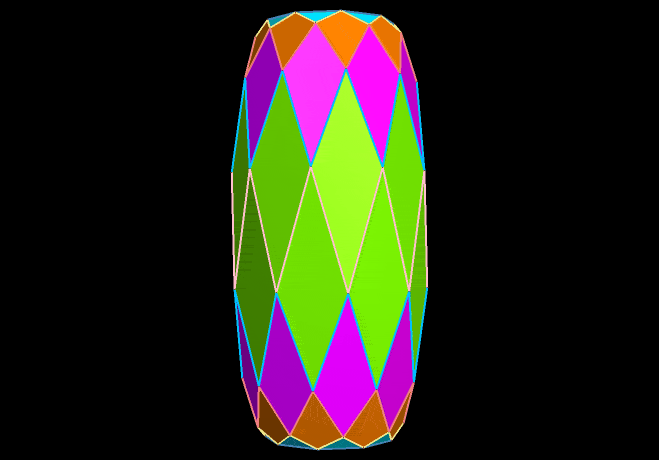 |
 |
| Animations made using Stella Polyhedron Navigator | |||
The challenge is the questionable relevance of any such mapping to the 45 cells of the matrix in clustering the set of tone-value polarities. They can best be understood as framed dynamically (by implication, and as such appropriately), by any implied alternation between the zonohedron and its dual form. Arguably this would be consistent with the case for understanding values as dynamic rather than static, as is conventionally the case (Freedom, Democracy, Justice: Isolated Nouns or Interwoven Verbs? Illusory quest for qualities and principles dynamically disguised, 2011).
Comprehension of how tone-values might be implied by a dynamic can be explored through the challenges to the imagination of the topological morphing between the zonohedron and its dual. There are a various forms of morphing, as illustrated by the animations below in solid variants from contrasting perspectives.
| Animations of distinctive morphing transformations of 9-frequency zome to/from dual | |||
| Morphing: sizing | Morphing: sizing | Morphing: truncation | Morphing: truncation |
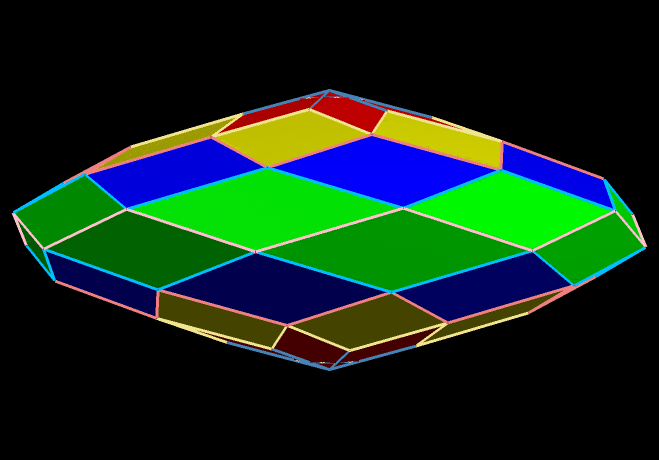 |
 |
 |
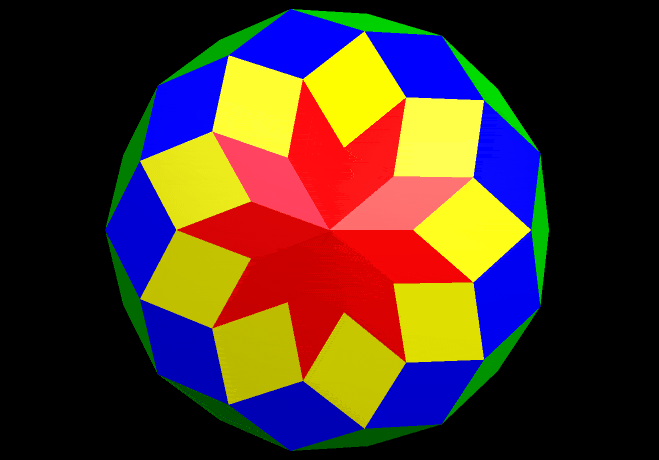 |
| Morphing: augmentation | Morphing: augmentation | Morphing: expansion | Morphing: expansion |
 |
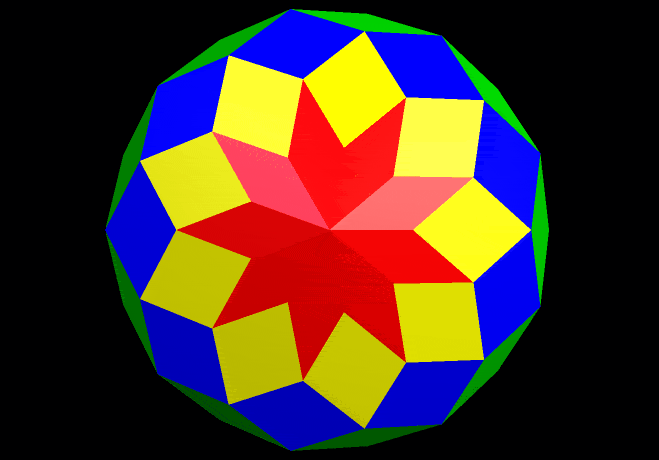 |
 |
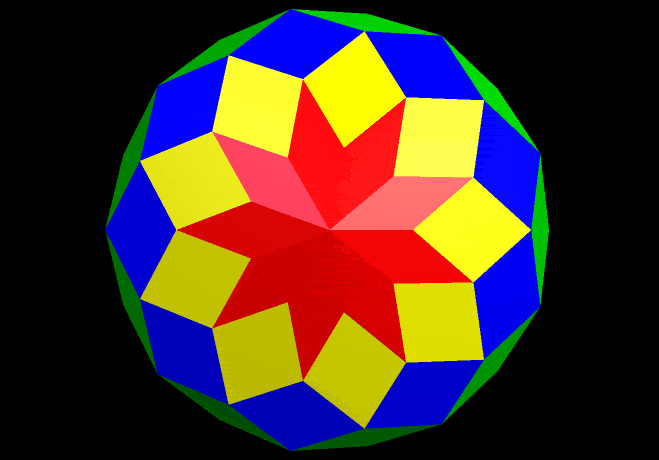 |
| Morphing: tilting quadrilaterals | Morphing: tilting quadrilaterals | Morphing: tilting triangles | Morphing: tilting triangles |
 |
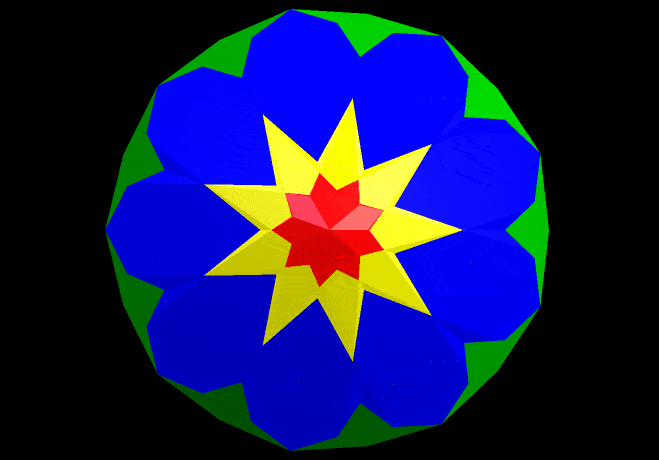 |
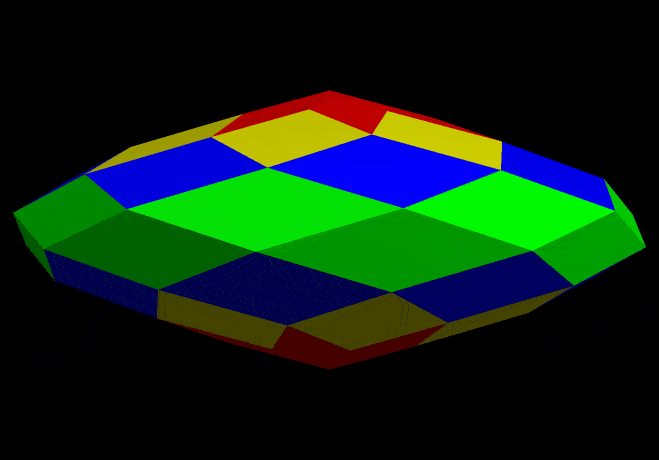 |
 |
| Animations made using Stella Polyhedron Navigator | |||
Evoking imaginative appreciation of possibilities of tone-of-voice coherence
The argument merits further development given both the fundamental importance of human values and the higher order of coherence which the communication of global strategy would appear to require. This contrasts with the assumption that the set of values and of tone-of-voice can be adequately presented as a simple checklist as is currently the case. As noted above, such checklists could indeed be caricatured as "laundry lists" and as such effectively unworthy of their potential importance for society -- despite any efforts to promote better "whiteners".
The following is therefore a presentation of polyhedral forms indicative of higher orders of coherence -- as potential mapping templates for tone-of-voice values as they might be understood. They are presented as examples of catalysts for imaginative reflection evoking the question of how the requisite coherence might be understood.
In the light of the metaphorical implication of diamond (as presented below), the various configurations could be considered as examples of gemstones or precious stones. A configuration of values could then be appropriately evaluated in terms of brilliance, fire and scintillation. As with the varieties of crystal (ordered as a crystal system) from which precious stones are cut, this suggests a pattern language for values and tone-of-voice whose possibilities remain to be explored.
Using 45 value clusters from the 9x5 matrix: Although seemingly rare, one candidate is the triaugmented dodecahedron with 45 edges of 15 types (distinctively coloured), 23 vertices of 9 types (not highlighted). and 24 faces of 8 types. The dual necessarily has 45 edges of 15 types, 23 faces of 9 types (distinctively coloured), and 24 vertices of 8 types (not highlighted).
| Presentation of 45 value clusters on the 45 edges of a polyhedron | |||
| triaugmented dodecahedron | dual of triaugmented dodecahedron | ||
| solid | wire frame | solid | wire frame |
 |
 |
 |
 |
| Animations made using Stella Polyhedron Navigator | |||
Using value polarities (ca. 230) clustered by the 9x5 matrix: It is of course questionable whether the value polarities indeed number 230 -- for which there are no polyhedra suitable for mapping. It is therefore appropriate to explore the possibility of mapping onto polyhedra with characteristics approximating that number, whether as axes or edges.
The closest approximation to 230 value polarities for which polyhedra were detected is 228. Only two polyhedra were found with 228 edges, namely the hendecagonal-faced polyhedron (below left) and the 6-frequency octahedral geodesic hemisphere (excluded from consideration because of its spherical asymmetry).
| Animations of polyhedra of potential use in mapping value polarities | |||
| Using value polarities (ca 230 edges) | Using value polarities (ca 230 axes) | ||
| Hendecagonal-faced polyhedron 228 edges 10 types); 144 vertices (6 types); 86 faces (5 types) |
Squares+Heptagons (with dual below) |
Stewart toroid -- Genus 46 (with dual below) |
|
| Polyhedron (with dual below) | Morphing variants | 420 vertices (15), 798 edges (29), 378 (15) | 458 vertices (458), 934 faces (934), 1482 edges (1482) |
 |
 |
 |
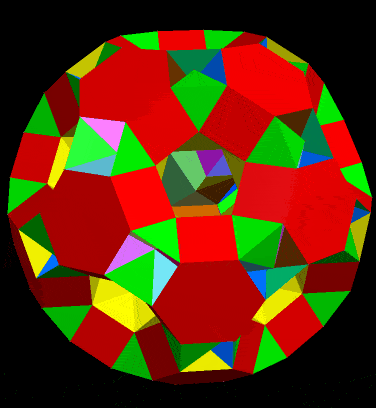 |
 |
 |
 |
 |
| Animations made using Stella Polyhedron Navigator | |||
If the memorability of a coherent configuration is appropriately explored through its numeric factors, then the following merit comparison in the light of the arguments for lower numbers and simpler polyhedra as presented separately (Identifying Polyhedra Enabling Memorable Strategic Mapping: visualization of organization and strategic coherence through 3D modelling, 2020).
| Indication of numeric factors for possible configurations of value polarities | ||||
| value polarities | factors # | component factors | factorization | polyhedra (edges) |
| 228 | 12 | 1, 2, 3, 4, 6, 12, 19, 38, 57, 76, 114, 228 | 22 × 3 × 19 | 2 |
| 230 | 8 | 1, 2, 5, 10, 23, 46, 115, 230 | 2 × 5 × 23 | 0 |
| 234 | 12 | 1, 2, 3, 6, 9, 13, 18, 26, 39, 78, 117, 234 | 2 × 32 × 13 | 0 |
| 240 | 20 | 1, 2, 3, 4, 5, 6, 8, 10, 12, 15, 16, 20, 24, 30, 40, 48, 60, 80, 120, and 240 | 24 × 3 × 5 | 24 |
| 250 | 8 | 1, 2, 5, 10, 25, 50, 125, 250 | 2 x 53 | 1 |
The range of polyhedra associated with the high degree of factorization evident for 240 merits particular attention -- if the value polarities were indeed considered to cluster in terms of such a pattern -- potentially in the light of cognitive constraints on comprehension and memorability. Does 240 "work", for reasons similar to arguments made for Dunbar's number -- as indicated by the various checklists of tone-of-voice words of precisely that size?
| Illustrative selection of polyhedra with 240 edges of potential value for mapping value polarities | |||
| Great Dirhombicosidodecahedron | Bruckner 29,6 | Icosahedron_8 | Small Rhombihexahedra_5 |
 |
 |
 |
 |
| Animations made using Stella Polyhedron Navigator | |||
Using configurations in 4D: Whilst the predominant tendency is to order tones-of-voice and human values in 2D (checklists, etc), the examples above suggest the possibility of configurations of potentially greater coherence in 3D. However it is too readily assumed that the challenge for their fruitful organization can be resolved in 3D. Ordering in 4D (or more) may be more consistent with the requisite value complexity and the manner in which the variety is to be experienced.
The issue goes to the heart of the question as to whether human beings are most appropriately understood as three-dimensional, as challenged by various authors:
- Ron Atkin: Multidimensional Man: can man live in 3-dimsnional space (1982)
- Antonio de Nicolas: Meditations through the Rig Veda: four-dimensional man, (1976)
- Laurence Scott: The Four-Dimensional Human: ways of being in the digital world (2015)
- T. N. Aflalo and M. S. A. Graziano: Four-Dimensional Spatial Reasoning in Humans (Journal of Experimental Psychology, 34, 2008, 5)
- Michael S. Ambinder, et al: Human four-dimensional spatial intuition in virtual reality (Psychonomic Bulletin , 16, 2009)
- Michael D'Zmura: et al: Virtual environments with four or more spatial dimensions (Presence: Teleoperators and Virtual Environments, 9, 2000).
- Rudy Rucker: The Fourth Dimension: toward a geometry of higher reality (1984).
- John Mazziotta, et al: A Four-Dimensional Probabilistic Atlas of the Human Brain (Journal of the American Medical Informatics Association, 8, 2001, 5)
- Tim Andersen: A 5th dimension may explain quantum theory (Medium, 2020)
Of particular relevance to the conceptual framing of the strategic environment of the future is the manner in which higher dimensionality is now explored from a military perspective:
- James E. Zanol and Brian M. Pierce: Overcoming the Challenges in Implementing Emerging Maneuver Concepts (Military Review, 2018, May-June)
- Brian M. Pierce and James E. Zanol: MANeuver in N-Dimensional Terrain (MAN^N): a full spectrum maneuver concept (Small Wars Journal, 24 January 2012)
- Expanding Maneuver in the Early 21st Century Security Environment (white paper, USASOC, 12 January 2017).
- Cognitive Maneuver For the Contemporary and Future Strategic Operating Environment (white paper, U.S. Army Special Operations Command [USASOC], 31 May 2016)
Unlike 3D configurations, those in 4D cannot be represented conventionally. The following illustrate use of 3D aspects or projections of 4D configurations.
| Examples of aspects of 4D configurations (3D aspects) | |
| 14-Gofix Slice -- 452 vertices | Dual of 330 Gippid -- 240 edges |
 |
 |
| Animations made using Stella Polyhedron Navigator | |
The relevance can be speculatively explored with respect to the organization of NATO (Envisaging NATO Otherwise -- in 3D and 4D? Potentially hidden faces of global strategy highlighted through polyhedra, 2017). In discussing NATO as a 4D entity, this notes the vast array of four-dimensional analogues to 3D polyhedra, known as polychora, with the possibility of animating 3D cross-sections in real-time and 4D rotation. Their relevance is discussed separately (Four-dimensional requisite for a time-bound global civilization? 2015; Comprehending the shapes of time through four-dimensional uniform polychora, 2015; Five-fold ordering of strategic engagement with time, 2015).
Insights from diamond as symbolic of the highest value
There is a case for exploring the relevance of the structure of a diamond in the light of its role as a comprehensible symbol of the highest value -- both in a material and an aesthetic sense. The various checklists of tone-of-voice and of human values can indeed be caricatured as "laundry lists" which fail to honour their significance. As such they are comparable with uncut diamonds, rather dull looking lumps difficult for the uninformed to distinguish from water-worn quartz pebbles. Whilst somewhat interesting, they are nothing like the sparkling beauty of gemstones resulting from skillful cutting.
As a metaphor, is it to be imagined that conventional presentation of proposals for global strategy, purportedly exemplifying the highest human values, are then to be compared with uncut diamonds -- inherently, although potentially valuable?
A brilliant is a diamond or other gemstone cut in a particular form with numerous facets so as to have exceptional brilliance. The facet arrangements and proportions of the round brilliant cut have been perfected by both mathematical and empirical analysis. Although the facet count is conventionally invariant, the proportions are not. The shape resembles that of a cone and provides maximized light return through the top of the diamond. A number of other diamond cuts are recognized. As described by Wikipedia:
The modern round brilliant consists of 58 facets (or 57 if the culet is excluded), ordinarily today cut in two pyramids placed base to base: 33 on the crown (the top half above the middle or girdle of the stone), truncated comparatively near its base by the table, and 25 on the pavilion (the lower half below the girdle), which has only the apex cut off to form the culet, around which 8 extra facets are sometimes added. In recent decades, most girdles are faceted. Many girdles have 32, 64, 80, or 96 facets; these facets are not counted in the total. While the facet count is standard, the actual proportions (crown height and angle, pavilion depth, etc.) are not universally agreed upon.
| Diamond proportions | Diamond facet names | |
 |
 |
 |
| Reproduced from Wikipedia. Copyright 2001-2005 by Jasper Paulsen | ||
The curious point to be emphasized is that a cut diamond is esteemed to an unusual degree both for its value and its beauty. Both derive from the manner in which the facets together reflect and refract the incident light. It is for this reason that precious stones feature in emblems symbolic of the highest authority. Given the theological speculation noted above, the function of the pattern can be explored in terms of scriptural references to the original unity associated with both the originating word as a complex tone-of-voice and the accompanying phrase: Let there be light: and there was light. (Genesis 1:3).
The relevance to the argument above is discussed separately (Patterning Archetypal Templates of Emergent Order: implications of diamond faceting for enlightening dialogue, 2002; Summary of Gemstone Faceting and Crystals, 2002).
Given their central role in relation to what is variously valued in society, it is appropriate to focus more precisely on the metaphorical reference to key properties distinguished in diamonds, as they are evident in the presentation of any strategy through tone-of-voice:
- brightness (or brilliance): the intensity of the effects of external (surface) and internal reflections of white light, as a consequence of its high refractive index. Diamonds that are too shallow or too deep return less light. A high level of brilliance will also be attained if the diamond is well-balanced and symmetrical with properly aligned facets.
- fire: resulting from the interaction of white light interacts with diamond facets, thereby transformed by refraction into spectral colours -- a wide range of warm and cool colours. The dispersion into colours results in these taking different paths because the amount by which they are refracted by the material differs.
- scintillation: understood as subdivided into sparkle and pattern. Sparkle is evident in intense flashing spots of light, produced when tilting a diamond from side to side to see how light dances through the facets and across the crown -- ideally with their size and distribution even and balanced. Scintillation is a product of both brilliance (white light reflection) and dispersion (rainbow of colours, namely fire). Pattern is recognized in terms of the relative size, arrangement, and contrast of bright and dark areas that result from a diamond's internal and external reflections whereby virtual facets are perceived by the overlapping of actual facets.
Whilst the inclusion of more facets than the standard 57 or 58, might increase the number of reflective surfaces on the diamond, it might thereby decrease the size of the sparkle to the extent where it becomes difficult to see the dispersion of the reflected white light into flashes of coloured light. Diamonds are cut to exhibit a full balance of brilliance (white sparkle) and dispersion (coloured sparkle) by knowing how to balance the proportions of the diamond, whilst arranging each facet so that it is optimized to reflect the maximum amount of light towards the observer. Failure in this respect is visually indicated by the Ideal Scope Referernce Chart.
These properties are a consequence of the total internal reflection of light within the diamond. Arguably the articulation of a strategy depends on corresponding processes effectively dependent on the internal coherence of the pattern of values configured and clustered as polarities.
Clarification is available in a variety of presentations (Why do diamonds shine? Physics StackExchange; Brightness, Fire and Scintillation of diamonds; Understanding Diamond Light: Scintillation, Dispersion, Brilliance, and Fire; What Makes A Diamond Sparkle? Understanding Diamond Scintillation; Diamond Fire, Brilliance and Scintillation; Diamond Sparkle: Why Do Diamonds Sparkle?).
| Exploratory adaptation of 9-frequency zome to simulate a diamond brilliant cut | |
| 9-frequency zonohedrified antiprism | Animation of face colours of zome |
 |
 |
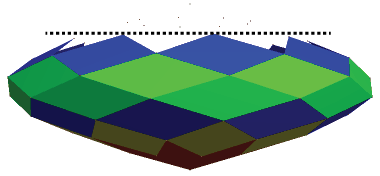 |
|
| Images and animations made using Stella Polyhedron Navigator | |
The diamond is also especially valued because of its hardness. As a metaphor, hardness also translates into strategic discourse in the form of a hard argument for which 97 synonyms have been offered (Hard argument synonyms, Power Thesaurus). These include the following, interlinked with each other -- each with its own set of synonyms, and thereby suggestive of the kind of cognitive coherence implied by a diamond:
| strong case (322 synonyms) compelling reasons (159 synonyms) forcible argument (97 synonyms) persuasive argument (187 synonyms) strong argument (224 synonyms) |
solid evidence (313 synonyms) good reason to believe (140 synonyms) logical proof (99 synonyms) justified argument (97 synonyms) irrefutable evidence (132 synonyms) |
Such metaphors reinforce the point that it is not the hardness of the rational argument for any global strategy that is adequate to the challenge. As illustrated by the diamond, it is the manner by which it is cut that renders the aesthetic experience of it so attractive -- and valuable to so many.
Tone-of-voice insights from music and the organization of the Tonnetz
Musical accompaniment of a Global Reset? It is unclear how justified it may be to explore the relation between tone in music and that in tone-of-voice. Clearly a degree of association is recognized and exploited in practice, especially in use of musical metaphors to distinguish tones-of-voice. It may well be seen as appropriate to accompany or introduce any presentation of a strategy with the use of music as a means of branding the strategy through associating music with however the tone-of-voice is understood (as described above).
Of concern is necessarily whether the choice of music should be governed by the criteria conventionally associated with an advertising jingle -- or martial music, according to a different tradition.
Geometry of music: The merit in exploring further is the sense in which the organization of tones as experienced in music has progressed far beyond what might be readily associated with scales and musical notation as conventionally represented. This suggests that there are new ways of comprehending the coherence of music which may be of value to comprehension and use of tones-of-voice -- and to the articulation of strategy.
The research of particular interest is notably associated with the manner in which the human brain appears to organize the patterns of tones that is appreciated, as clarified by the work of Dmitri Tymoczko relating music and geometry (A Geometry of Music: harmony and counterpoint in the extended common practice, 2011; The Geometry of Musical Chords, Science, 313, 2006). The manner in which such organization of tones in musical tuning and harmony has long been been explored in terms of the Tonnetz (a tone-network), namely a conceptual lattice diagram representing tonal space. Tymoczko has developed his understanding through its generalization (The Generalized Tonnetz, Journal of Music Theory, 56, 2012. 1).
Musical theory has notably developed further through a loose collection of ideas termed Neo-Riemannian theory. These are characterized by a central commitment to relating harmonies directly to each other, without necessary reference to a tonic. Extended progressions of harmonies are characteristically displayed on a geometric plane, or map, which portrays the entire system of harmonic relations. Where consensus is lacking is on the question of what is most central to the theory: smooth voice leading, transformations, or the system of relations that is mapped by the geometries.
Of potential relevance to any organization of human values, Neo-Riemannian transformations can be modeled with several interrelated geometric structures. The Riemannian (tonal grid, left below) is a planar array of pitches along three simplicial axes, corresponding to the three consonant intervals. Major and minor triads are represented by triangles which tile the plane of the Tonnetz. Edge-adjacent triads share two common pitches, and so the principal transformations are expressed as minimal motion of the Tonnetz. Pitches in the Tonnetz are connected by lines if they are separated by minor third, major third, or perfect fifth. Interpreted as a torus the Tonnetz has 12 nodes (pitches) and 24 triangles (triads).
Various experimental graphical representations of the Tonnetz have been presented:
- a toroidal view (below centre) has been proposed by David Bulger, and revised subsequently (David Bulger and Richard Cohn, Constrained voice-leading spaces, Journal of Mathematics and Music, 2015)
- an embedding of the Tonnetz on a 4D Hypersphere (below right) based on graph theory, as proposed by Gilles Baroin (The planet-4D model: An original hypersymmetric music space based on graph theory, 2011).
A valuable discussion of such possibilities is provided by Jason Yust (Organized Time: rhythm, tonality, and form, 2018; Geometric Generalizations of the Tonnetz and their Relation to Fourier Phases Spaces, 2017)
| Selection of graphical representation of the Tonnetz | ||
| Planar organization of the Tonnetz |
Toroidal view of the neo-Riemannian Tonnetz |
Planet-4D embedding theTonnetz on a 4D hypersphere |
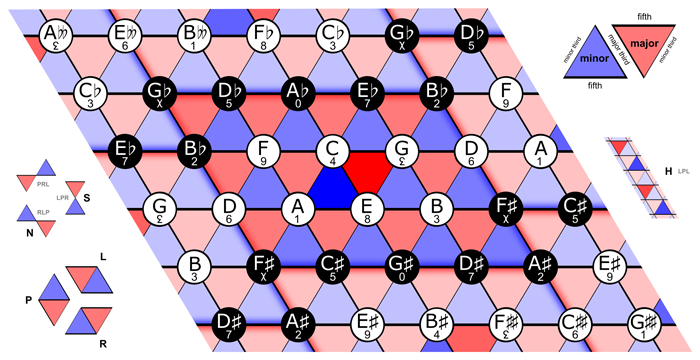 |
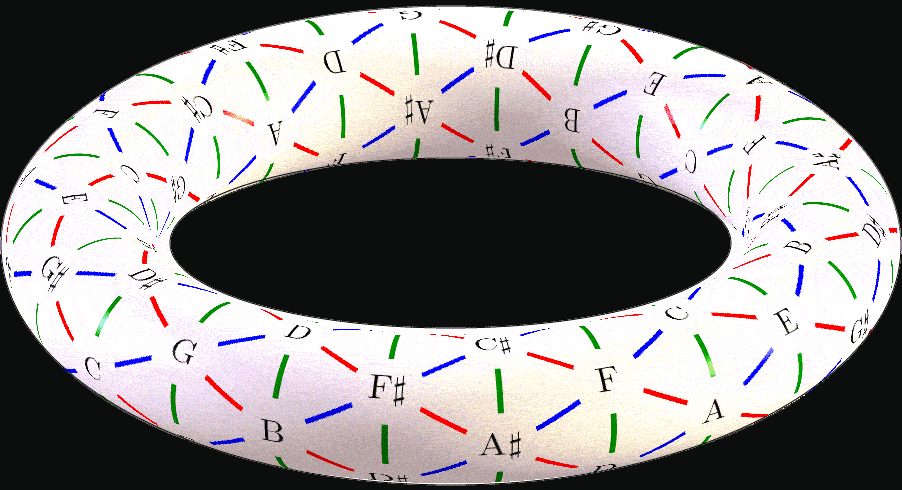 |
 |
| Watchduck (a.k.a. Tilman Piesk), CC0, via Wikimedia Commons | Adaptation of Davidwbulger, Public domain, via Wikimedia Commons | Gilles Baroin PHD, Public domain, via Wikimedia Commons |
It is intriguing that the focus on the Tonnetz offers explanations articulated by triangular modelling in various configurations, some lending themselves readily to 2D visualizations with tonal accompaniment. Nothing appears to be said about how the articulation is experienced, even though it could be said to be about the potential experience of an organized array of tones -- although an exception is the argument with regard to the Cognitive Interpretation of the Tonnetz (Robert Lieck, et al., The Tonal Diffusion Model, Transactions of the International Society for Music Information Retrieval, 3, 2020, 1). This then helps to frame the question of the nature of the cognitive engagement with the potentiality of a global array of tones-of-voice or of human values. The question acquires greater focus if the experiencer is recognized as located at the centre of a spherically symmetrical polyhedron -- especially one whose faces are triangulated. Aspects of the challenge of triadic thinking with respect to any mapping are discussed separately (Triangulation of Incommensurable Concepts for Global Configuration, 2011).
The models above are all suggestive of an imaginative approach which could be considered appropriate to the visualization of tones-of-voice and human values of relevance to representation of global strategy. In contrast to the "flatland" of checklists, the cognitive implications of the torus as a design metaphor, are discussed separately (Imagining Toroidal Life as a Sustainable Alternative: from globalization to toroidization or back to flatland? 2019).
Of relevance to this supposition is the language and preoccupation of a recent study (A. Milne, D. Bulger and S. A. Herff, Exploring the space of perfectly balanced rhythms and scales, Journal of Mathematics and Music, 11, 2017, 2-3):
Periodic scales and meters typically embody "organizational principles" -- their pitches and onset times are not randomly distributed, but structured by rules or constraints. Identifying such principles is useful for understanding existing music and for generating novel music. In this article, we identify and discuss a novel organizational principle for scales and rhythms that we feel is of both theoretical interest and practical utility: perfect balance. When distributed around the circle, perfectly balanced rhythms and scales have their "centre of gravity" at the centre of the circle. The present article serves as a repository of the theorems and definitions crucial to perfect balance. It also further explores its mathematical ramifications by linking the existing theorems to algebraic number theory and computational optimizations.
Relevance of tone-of-voice to global strategy presentation
As articulated through static checklists, tones-of-voice and human values offer very limited insight into the dynamic reality with which global governance is called upon to engage. Notably missing is the creative process through which the shift within the pattern of possible tones-of-voice is ensured. Clues as to the nature of this process are offered to a remarkable degree by music -- and the interplay between harmony and discord, point and counterpoint.
This understanding has notably been presented in the study by Douglas Hofstadter (Gödel, Escher, Bach: an Eternal Golden Braid, 1979). With modulation as a metaphor central to music, the question is how global governance might be characterized by shifting within a pattern of connectivity. The graphical representations above of the Tonnetz offer pointers in this respect.
In contrast with the unchanging form of any anthem deemed fundamental to the articulation of national identity, there is the reality of the lipservice paid to it by those who prefer a multiplicity of musics and the choices they offer. If any proposed Global Reset is be associated like an anthem with musical accompaniment, what form might it take to evoke and sustain a shift in identity, and the threats thereto as can be variously explored (A Singable Earth Charter, EU Constitution or Global Ethic? 2006; Reversing the Anthem of Europe to Signal Distress: transcending crises of governance via reverse music and reverse speech? 2016).
Potentially more intriguing with respect to modulation and the future role of artifical intelligence, is it possible that "organizing" global governance will be enriched by the musical understanding of the organ as an instrument to be played (Envisaging a Comprehensible Global Brain -- as a Playful Organ, 2019)?
There is some irony to the number of references to "tones-of-listening" in contrast to "tones-of-voice", and its association with the much-cited reference to the poem of Wallace Stevens (Thirteen Ways of Looking at a Blackbird, 1917). Global governance, COVID-19, and climate change, may call for such "tones-of-hearing" (Hearing the Variety of Voices in Climate Change Discourse: recognizing the challenge of soundscape comprehension in controversy and emergency, 2019). The latter included the following sections:
| Climate change discourse according to classification of singing voice types? Types of singing as indicative of modes of climate change discourse Distinctions of voice in the art of climate change rhetoric? Gravitas as the requisite voice for crisis and climate emergency? Unquestionable voices of authority and command in a context of emergency? Engendering a reality distortion field for climate change: the role of charisma? Distinctions of tone and voice of value in addressing climate change |
Orchestration of a requisite variety of voices in response to climate change? |
Any tongue-in-cheek implications aside, of some relevance is the sense that climate change may call for a wide variety of voices -- potentially reflecting the complexity of the situation, the variety of climate types, and even the biodiversity endangered by any change. The question lends itself to speculative reflection -- readily comprhensible to the ever young (Enrolling Winnie-the-Pooh's Companions in Climate Change Discourse: key roles in the environmental psychodrama of Hundred Acre Wood, 2019).
Reframing Spaceship Earth as Toneship Earth?
The spaceship metaphor has long been widely used as a much-appreciated trigger for the imagination -- as is evident by movie-enhanced speculation on space travel and extraterrestrials. It could however be argued that current global challenges derive in part from considering the Earth itself as a spaceship -- as in use of Spaceship Earth.
This is a world view highlighting the limited resources available and encouraging harmonious action -- as with a crew working toward the greater good. Strategically, as explored in science fiction, there is however significant incapacity to engage with the longer periods of time which might be associated with any notion of "Timeship Earth" (Strategic Embodiment of Time: configuring questions fundamental to change, 2010).
Given the role of music in enabling complex comprehension of time, and the argument above with respect to tones-of voice, there is a case for imagining the possibility of "Toneship Earth", as might be speculatively envisaged (Toneship design to enable noonautics by the voices of civilization? 2015).
Arrays of tones vs Arrays of tone descriptors? Given the 37-fold articulation of possibly the most succinct set of tone-of-voice descriptors (as noted above), this constitutes a challenge to how any implied coherence to the set might be memorably represented, as explored separately (In quest of number 37 through the pattern of spherical polyhedra, 2015). In that argument the question of pattern organization was considered (Requisite variety of "voices" for psychosocial wholth: 6, 8, 12, 20, 30? 2015).
Exploration there of the possible key role of 37 was triggered by a review of the much-cited research of a cosmologist and an astrobiologist by Christopher Kemp (Is the answer to life, the universe and everything 37? New Scientist, 16 December 2014). The focus on the role of 37 in the genetic code is potentially consistent with other research regarding DNA (Martin Blank, et all, DNA is a fractal antenna in electromagnetic fields, International Journal of Radiation Biology, 87, 2011, 4).
Of somewhat ironic relevance to any 37-fold pattern are the unrelated studies by the musicologist Ernest McClain (The Myth of Invariance: the origin of the Gods, Mathematics and Music from the Rg Veda to Plato, 1976; The Pythagorean Plato: prelude to the song itself, 1978). McClain notably discusses how a tonal system is engendered by prime numbers 2, 3, 5, and 7. Using the mathematics of lattice arrays, McClain notes in particular the 50 enigmatic references to the "37 guardians" in Plato's Laws. He therefore uses primes to order tonal values and sets the resulting 37 tones elicited into the following lattice, in a detailed argument taking account of other number bases characteristic of those times (notably 60).
As shown below left, a centered hexagonal number is a centered figurate number that represents a hexagon with a dot in the center and all other dots surrounding the center dot in a hexagonal lattice.
| Hexagonal arrays | |
| Centered hexagonal number | 37 Tonal values in hexagonal lattice array |
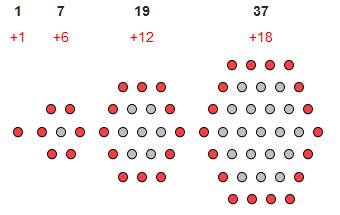 |
 |
| Reproduced from Wikipedia | (Reproduced from McClain, Meditations Through the Quran: tonal images in an oral culture, 1981, p. 95) |
"Toneship design"? The previous argument with regard to the organizing role of 37 concluded by speculatively framing the challenge of "toneship design". The question was onto what polyhedra might a 37-fold pattern be mapped:
- onto axes, namely polyhedra with 74 vertices, such as the 6-frequency tetrahedral geodesic sphere or the stellated cuboctahedron -- on the assumption that the 37 elements each imply a polarity in the case of the tones-of-voice
- onto faces, namely those indicated below. reproduced from the earlier exercise. That on the right is the polyhedron named "Wings". It is a polyhedron with 37 faces (of 19 types), 65 edges (5x13 of 33 types), 30 vertices (of 15 types). Its features total to 22x3x11, with a product of 2x3x52x13x37.
| Speculative animation of possible "toneship" designs with 37 faces to which 37 tones are attributed (tones attributed arbitrarily to faces for purposes of illustration) |
||
| 3-frequency octahedral geodesic hemisphere | "Star tower" | "Wings" |
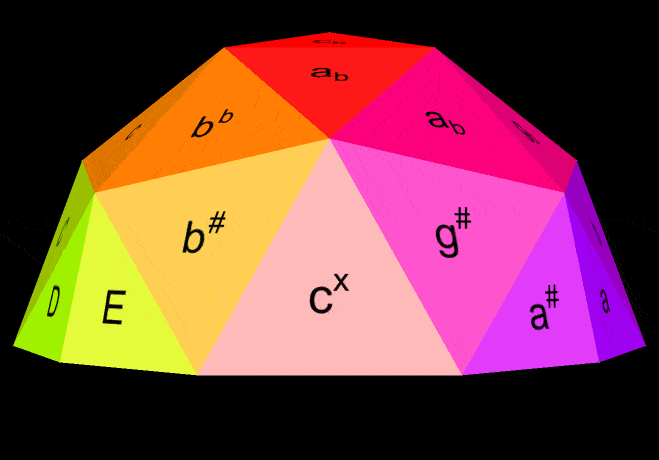 |
 |
 |
| Speculative animation of possible "toneship" designs with 37 faces to which 37 tones-of-voice are attributed (tones-of-voice attributed arbitrarily to faces for purposes of illustration) |
||
 |
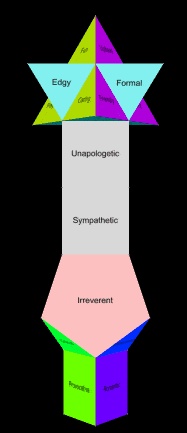 |
 |
| Images and animations made using Stella Polyhedron Navigator | ||
The use of polyhedral features in this way recalls the long tradition of the method of loci, fundamental to mnemonics, as described by Frances Yates (The Art of Memory, 1966). In that light a toneship could then prove comparable to a memory palace or a memory theatre. Of potentially greater relevance, from an environmental perspective, is the function of a memorial garden -- as may have been the primary role of a philosopher's garden (Damon Young, In the Philosopher's Garden, Financial Review, 13 December 2012). As emphasized in the classic Chinese treatise on gardens, garden-making is then recognized as an exercise in world-making (Ji Cheng, The Craft of Gardens, 1631). To be able to make a garden, the garden maker needs to meld with the landscape on the site, where natural phenomena become mnemonics. It is the ecology of nature, including man, which motivates and moves design
References
Ron Atkin. Multidimensional Man: can man live in 3-dimsnional space. Penguin, 1982
David Cheetham. Ways of meeting and the theology of religions. Routledge, 2013
Norman D. Cook. Tone of Voice and Mind: the connections between intonation, emotion, cognition and consciousness. John Benjamins, 2002 [abstract]
Antonio de Nicolas. Meditations through the Rig Veda: four-dimensional man. iUniverse, 2003
Barbara Ehrenreich. Bright-sided: how the relentless promotion of positive thinking has undermined America. Picador, 2009
Douglas Hofstadter:
- I Am a Strange Loop. Basic Books, 2007 [summary]
- Gödel, Escher, Bach: an Eternal Golden Braid. Basic Books, 1979 [summary]
Ernest G. McClain:
- The Myth of Invariance: the origin of the gods, mathematics and music from the Rg Veda to Plato. Nicolas-Hays, 1976 [text]
- The Pythagorean Plato: prelude to the song itself, Nicolas-Hays, 1978 [text]
- Meditations Through the Quran: tonal images in an oral Culture. Nicolas-Hays, 1981 [text]
Albert Mehrabian:
- Silent Messages: Implicit Communication of Emotions and Attitudes. Wadsworth, 1981 [summary]
- Nonverbal Communication. Aldine-Atherton, 1972 [summary]
Mariana Montiel and Robert W Peck (Eds.). Mathematical Music Theory: algebraic, geometric, combinatorial, topological and applied approaches to understanding musical phenomena. World Scientific, 2018 [contents]
Rudy Rucker. The Fourth Dimension: toward a geometry of higher reality. Houghton Mifflin, 1984
Arielle Saiber. Canto XXXIII: The Song of the Return. In: Allen Mandelbaum (Ed.), Lectura Dante Paradiso, University of California Press, 2019
Arielle Saiber and Aba Mbirika. The Three Giri of Paradiso XXXIII. Dante Studies, 131, 2013, pp. 237-272 [text]
Laurence Scott. The Four-Dimensional Human: ways of being in the digital world. Cornerstone Digital, 2015
John Simmons:
- We, Me, Them and It: how to write powerfully for business. Texere, 2002
- The Invisible Grail: in search of the true language of brands. Texere, 2003
Dmitri Tymoczko: A Geometry of Music: harmony and counterpoint in the extended common practice. Oxford University Press, 2011 [summary]
Frances Yates. The Art of Memory. Routledge, 1966
Jason Yust. Organized Time: rhythm, tonality, and form. Oxford University Press, 2018
|
For further updates on this site, subscribe here |


